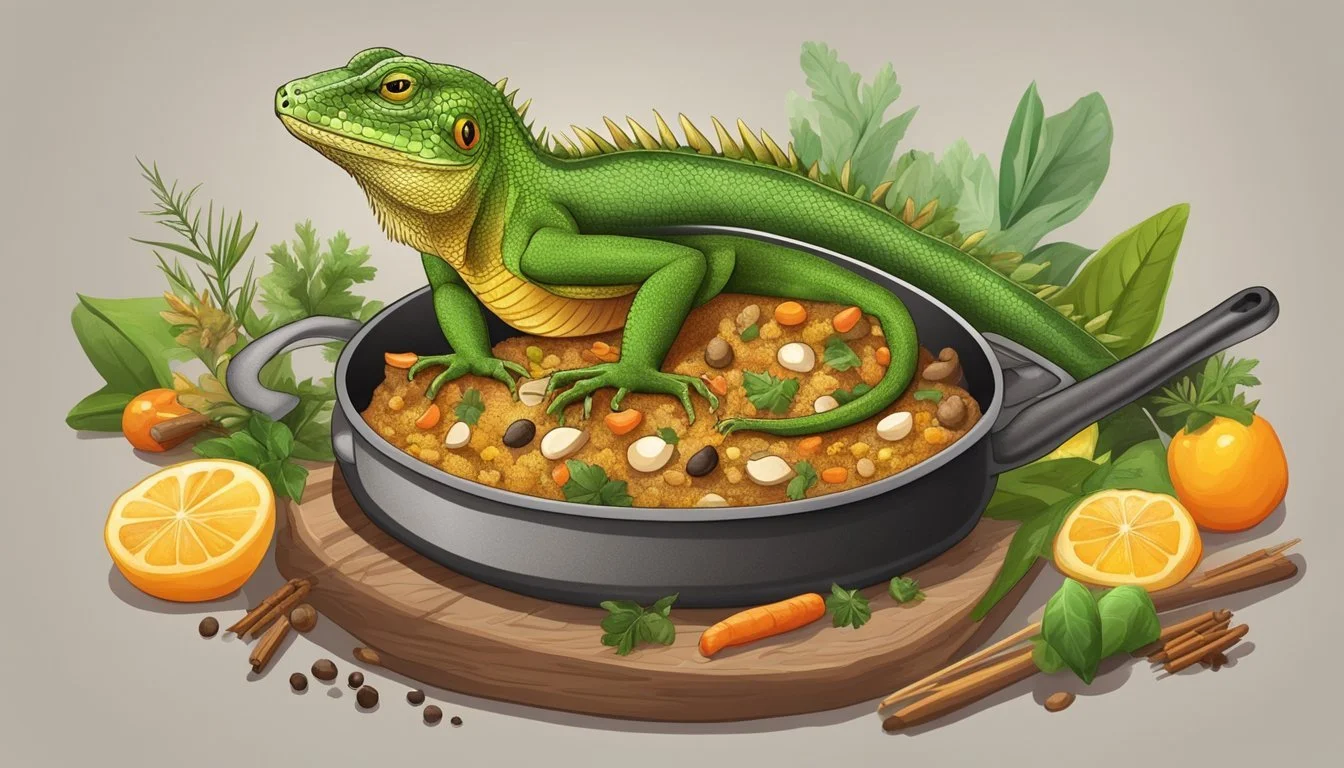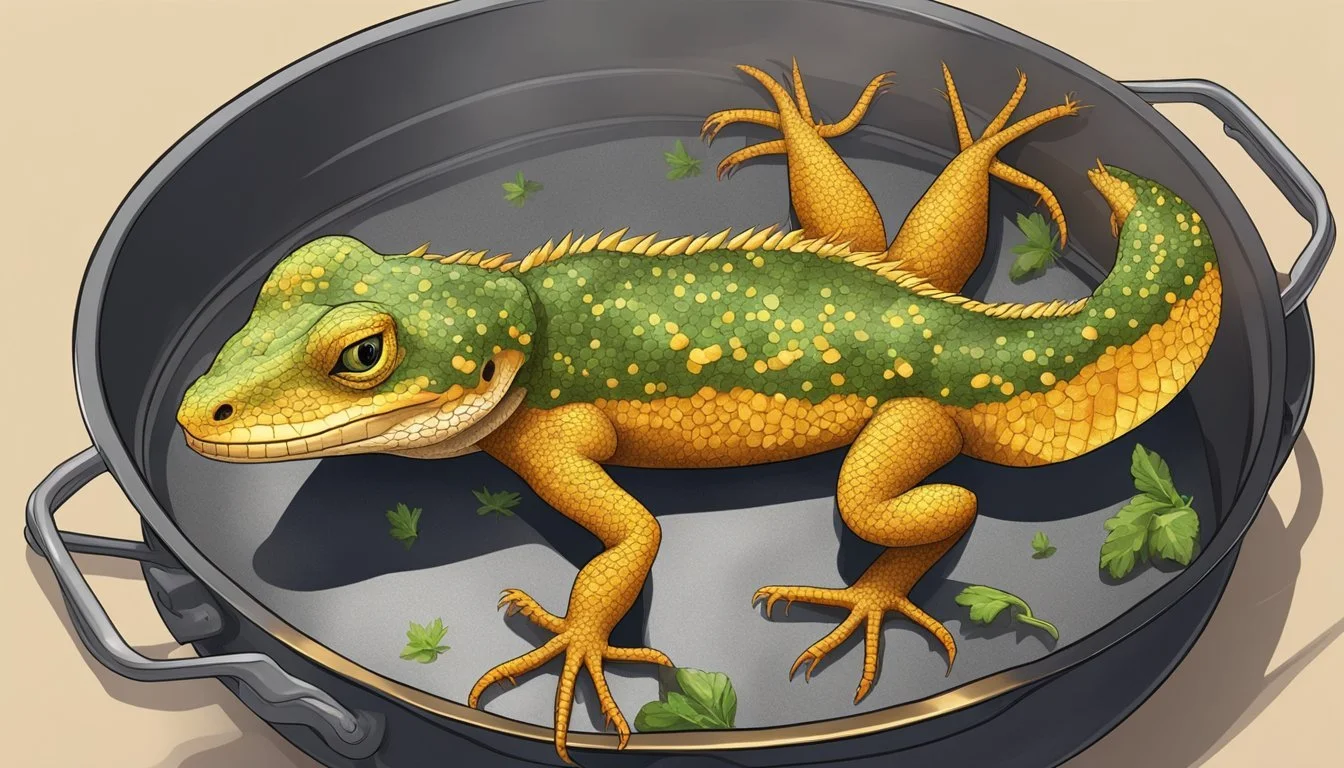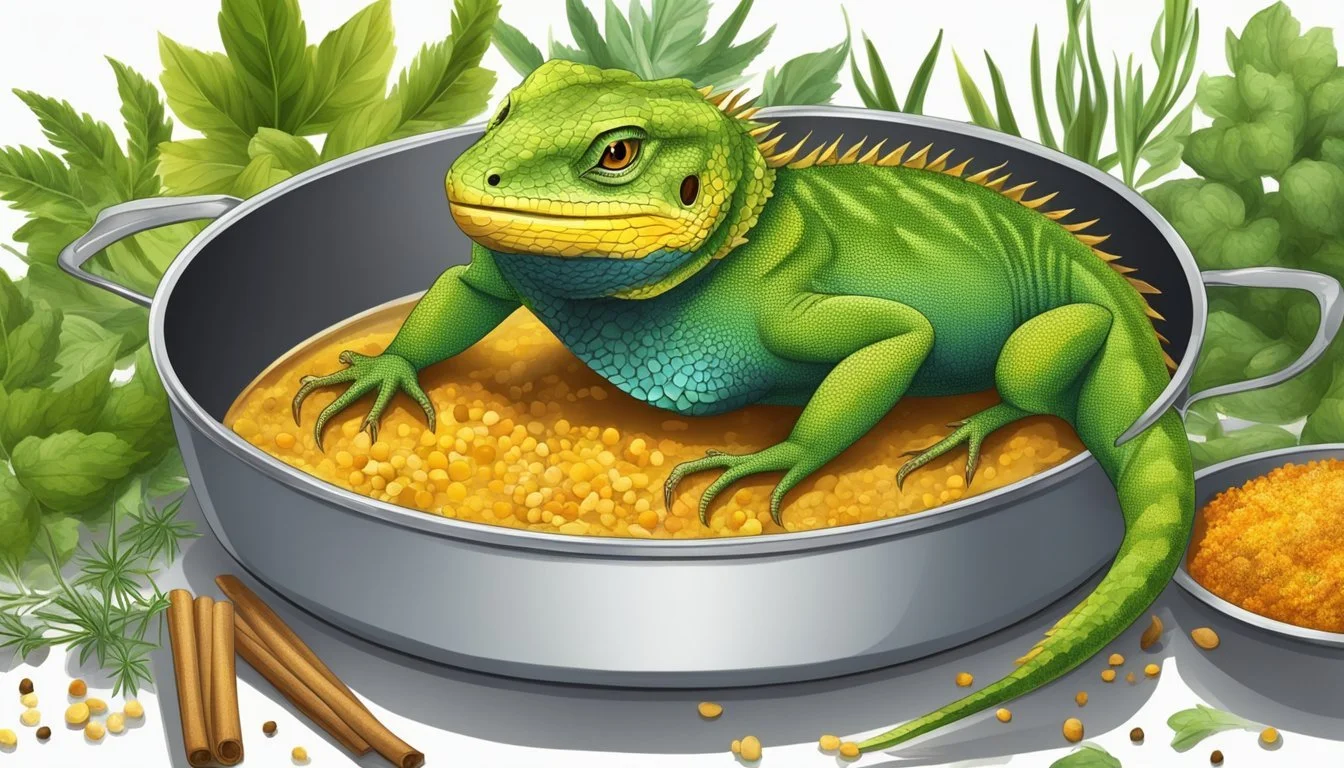Fried Lizard
Discovering Asia's Crunchy Delicacy Craze
Fried lizard is an Asian delicacy that has garnered attention for its role in cultural cuisines and its distinctive crunchy texture. This snack, often found in the street food scene, exemplifies the broad palette of flavors found across Asia, where unconventional animal proteins are more than just novelties—they are cherished parts of gastronomic heritage. The preparation involves deep frying the reptilian meat, resulting in a crispy outer layer that encases the tender flesh within.
In some Asian countries, lizards are considered a valuable source of protein and have been incorporated into traditional recipes for generations. The practice of frying lizards transforms the creature into a snack that's both satisfying to crunch and rich in taste. This snack is not merely an exotic challenge for daring tourists but a familiar treat for locals who appreciate its unique flavor profile and textural contrast.
Culinary adventurers and locals alike relish in the experience of sampling fried lizard, whether it's enjoyed with a cold beverage or as a standalone treat. Its presence in the street food markets speaks to a long-standing tradition of utilizing varied ingredients to create dishes that are both resourceful and delightful to the senses. As sustainability and broadening of dietary choices become increasingly relevant in global conversations, the intrigue surrounding such dishes lends itself to a deeper understanding of cultural identity expressed through food.
Evolution of Fried Lizard as a Delicacy
In Asia, fried lizard has evolved from a mere survival food to a sought-after delicacy. This journey mirrors the region's growing appreciation for unique, protein-rich foods.
Historically, lizards were a source of sustenance for many communities. Due to their abundance and ease of capture, they became a staple for those seeking a high-protein meal. Over time, the practice of frying lizards transformed into a culinary tradition in some Asian cultures, particularly in places like Vietnam, where food is celebrated for both its diversity and nutritional value.
Vietnam, known for its innovative and healthy cuisine, embraced fried lizard, elevating it with local flavors and cooking techniques. The lizard meat is often marinated with a blend of spices before being fried to achieve a crispy texture, commonly served as satay, which involves skewering and grilling the meat.
Nutritional Profile:
Protein: Essential for muscle repair and growth
Low Fat: Generally leaner than traditional meats
Vitamins and Minerals: Including vitamin B12 and iron
Over time, fried lizard has been transformed in presentation and flavor:
Initially simple, prepared over open fires
Now, it may include intricate spices and accompaniments like peanut sauce or shallots
The perception of fried lizard has shifted, with some consumers viewing it as an exotic treat that provides health benefits. As food tourism expands, so too does global curiosity about such dishes, leading to an increased demand and integration into mainstream Asian cuisine. The narrative of the lizard as a food source reflects both adaptation and the rich tapestry of Asian culinary heritage.
Health Benefits and Nutritional Value
Fried lizard, as a snack, offers a unique combination of benefits due to its high protein and fiber content, while also being a lower-calorie option compared to many conventional snacks (What wine goes well with snacks?). These elements make it a healthy and guilt-free choice for those seeking nutritious Asian snacks.
Protein and Fiber Content
Fried lizard is a rich source of protein, essential for muscle repair and growth, comparable to other traditional protein sources like chicken. Additionally, it provides dietary fiber beneficial for digestive health. For instance, while chicken provides an average of 27g of protein per 100g, fried lizard can offer a similar amount, making it a substantial protein-rich snack.
Low-Calorie Snack Options
When it comes to caloric intake, fried lizard emerges as a lower-calorie option. It can be a more favorable snack compared to choices like egg rolls or fried vegetables that are typically higher in calories. This can be attributed to its lower fat content and the absence of carbohydrate-rich coatings that are often found in other fried snacks.
Comparison to Other Snacks
Fried lizard's nutritional profile stands out when compared to other Asian snacks. For example, fried sesame seeds might provide healthy fats, but fried lizard offers a savory crunch without the high caloric count. As a healthy snack, it can be considered more of a guilt-free option than many deep-fried or processed snacks available on the market.
Culinary Techniques for Fried Lizard
In this section, readers will learn the precise methods to prepare lizard for frying, the essentials of the frying process, and the secrets behind achieving a delectable crust. Mastery of these techniques culminates in the creation of an unforgettable fried lizard snack.
Preparing the Lizard
The first step to making fried lizard is to ensure the meat is thoroughly cleaned and ready to absorb the flavors. One should start by cleaning the lizard with water and patting it dry. The lizard can then be cut into uniform pieces to ensure even cooking. It is essential to season the meat liberally with a mix of salt, sugar, and minced garlic to enhance its intrinsic flavors before it hits the pan.
Ingredients for seasoning:
Salt
Sugar
Minced garlic
Frying Essentials
For frying, one needs a heavy-duty frying pan or a deep-fryer filled with a high smoke point oil such as peanut or canola oil. The oil should be heated to a temperature that allows the lizard pieces to sizzle upon contact but not burn. They recommend maintaining an oil temperature between 350°F to 375°F for optimal results. Frying in small batches prevents overcrowding and ensures each piece is evenly crisp. After frying, placing the lizard on a wire rack over a baking sheet helps drain excess oil without making the pieces soggy.
Steps for frying:
Preheat oil to the correct temperature
Fry in small batches
Drain on wire rack
Creating the Perfect Crust
A tantalizingly crispy crust is what sets a great fried lizard apart. For achieving the perfect crust, a batter or corn starch coating is essential. The batter should coat the seasoned lizard pieces lightly, shaking off any excess before gently placing them in the oil. For a lighter crust reminiscent of tempura, a mixture of cold water, flour, and corn starch can be utilized. The key is a quick fry, as the lizard is typically thin-skinned and cooks rapidly, keeping an eye not to overcook the delicate meat.
Coating options:
Batter: creates a thick, crunchy coating
Corn starch: provides a lighter, crispier texture
Through meticulous preparation, careful monitoring of frying conditions, and a well-executed coating, fried lizard can be transformed into a crunchy, savory snack enjoyed across various Asian cuisines.
Traditional Recipes and Variations
Exploring the culinary landscape of fried lizard, enthusiasts will discover a rich tapestry of cooking methods and ingredient fusions. From classic preparations to innovative twists, each recipe offers a unique taste experience.
Classic Fried Lizard Recipe
In traditional recipes, chefs start by thoroughly cleaning the lizard before marinating it in a blend of citrus juices, typically sour orange, to tenderize and infuse flavor. The meat is later seasoned with salt and sometimes a dash of nutmeg for depth. To cook, the lizard is coated in beaten egg, crumbed, and fried until golden brown.
Ingredients:
Lizard, cleaned and cut into pieces
Sour orange juice (or a mix of sweet orange and lemon juice)
1 tsp whole black peppercorns
A dash of nutmeg
Salt to taste
Eggs, beaten
Fine bread crumbs
Cooking oil for deep frying
Instructions:
Marinate the lizard pieces for at least 3 hours.
Remove from marinade, pat dry, and season with salt.
Dip in egg, then breadcrumbs.
Fry in hot oil until crispy.
Fusion with Local Cuisines
Filipino culinary tradition, known for its diverse influences, presents an adaption of fried lizard called "Adobong Bayawak." This version is sautéed in a pan, then simmered with soy sauce and other ingredients until tender. The fusion creates a rich, savory snack that pairs well with rice or alcoholic beverages. The unique taste of adobong bayawak has piqued the interest of those keen on exploring exotic Asian snacks.
Adobong Bayawak Ingredients:
Bayawak meat
Soy sauce
Vinegar
Garlic, minced
Peppercorns
Oil for sautéing
Instructions:
Sauté bayawak until golden.
Add soy sauce, vinegar, garlic, and peppercorns.
Cook until tender, adding water as necessary.
Across Asia, fried lizard has inspired varieties of fried snacks. Incorporating local spices and serving styles, such as with rice crackers or paired with noodle dishes, has broadened its appeal. In some regions, the concept manifests in similar snacks like "Pakora" in South Asia, using different meats but applying analogous frying techniques to achieve that cherished crunchy exterior.
Serving Suggestions and Pairings
When serving fried lizard, a popular Asian delicacy known for its crispy texture, one should consider complementing it with the right dipping sauces and side accompaniments to enhance the overall flavor profile. Here are some suggested pairings.
Dipping Sauces and Condiments
Soy Sauce Mix: Combine soy sauce with a touch of brown sugar and a hint of mustard to create a perfect balance of salty-sweet sharpness suitable for dipping.
Spicy Sauce: A bold sauce can be made by mixing equal parts of chili sauce and rice vinegar, adding a unique kick that pairs well with the crunchy snack.
Accompaniments
Vegetables: Fresh or pickled vegetables (What wine goes well with pickled vegetables?) offer a refreshing contrast to the savory taste of fried lizard. They work well to cleanse the palate between bites.
Beer: A cold beer is an excellent beverage choice, its effervescence and bitterness complementing the rich and crispy texture of the fried lizard.
Rice Crackers and Noodles: Light and crispy rice crackers, as well as a bowl of subtly flavored noodles like pho, provide a contrasting texture while allowing the flavor of the lizard to shine.
Dietary Considerations
When considering fried lizard as a food option, individuals must take into account potential allergies and the importance of sourcing sustainably. These factors are crucial in ensuring the snack is both healthy and environmentally responsible.
Allergy Information
Individuals with allergies to similar proteins found in shellfish or other reptiles may need to exercise caution when consuming fried lizard. It is recommended that they consult with a healthcare provider before trying this snack. While uncommon, an allergic reaction could include symptoms such as:
Skin irritations: rashes or hives.
Gastrointestinal issues: nausea or vomiting.
Respiratory complications: difficulty breathing or wheezing.
Table 1: Potential Allergic Reactions to Fried Lizard
Symptom Type: Skin, Potential Reactions: Rashes, Hives
Symptom Type: Gastrointestinal, Potential Reactions: Nausea, Vomiting
Symptom Type: Respiratory, Potential Reactions: Breathing Difficulty, Wheezing
Note: Always carry allergy medication if you have known allergies and are trying new foods such as fried lizard for the first time.
Finding Sustainable Lizard Sources
A responsible consumer should seek out fried lizard from suppliers that prioritize sustainable practices. Unsustainable harvesting can lead to environmental damage and the depletion of local lizard populations. When sourcing, one should inquire about:
The environmental impact of the lizard harvesting methods.
If the species of lizard is endangered or over-harvested.
Points to consider when sourcing sustainable lizard:
Certification: Look for sustainability certifications from wildlife organizations.
Local regulations: Ensure suppliers adhere to local wildlife conservation laws.
When it comes to food choices, a healthy snack alternative like fried lizard can provide nutrition and satisfaction. However, steps should be taken to ensure these foods are safe and sustainable, keeping in mind the long-term health of our ecosystem.
Cultural Significance
In Asia, where food is an integral part of cultural expression, the practice of frying lizards and incorporating them into snacks encapsulates a blend of history, tradition, and local flavors.
Fried Lizard in Local Traditions
In various Asian cultures, fried lizard is not merely a source of sustenance, but a snack steeped in tradition. Vietnam, a country with a rich culinary diversity, is known for transforming the reptile into a crispy, savory snack. In rural areas and urban street corners alike, vendors can be seen selling these deep-fried delicacies, much to the delight of both daring tourists and local connoisseurs.
The snack's unique flavor and texture have made it an acquired taste that is often enjoyed as merienda, a light meal taken in the late afternoon in Filipino culture. As with other Filipino snacks, fried lizard provides a momentary escape from the hustle and bustle of daily life, offering a crunchy and flavorful experience that's both comforting and exotic.
Asian delicacies like fried lizard serve not only as food but also as a medium through which stories and customs are conveyed, allowing generations to maintain a tangible connection to their heritage and ancestors. It's a testament to Asia's vast food landscape—where even the most unconventional ingredients can find a place at the table.
Impact on Local Economy
The inclusion of fried lizard as an Asian delicacy has significant implications for local economies, particularly within regions where this dietary practice is prominent, such as Vietnam. By tapping into the market of exotic and traditional cuisines, local vendors and farmers are finding economic opportunities.
The production and sale of fried lizards contribute to the creation of small-scale industries. Individuals engaged in the hunting, farming, and preparation of these lizards are generating income, thus supporting themselves and their families. It's not uncommon to see street vendors or local markets thrive because tourists and locals alike are eager to experience this unique gastronomic offering.
Culinary tourism also benefits from such unique delicacies. Tourists are often drawn to authentic local experiences, which includes sampling traditional foods like fried lizard. This curiosity helps to sustain businesses that might otherwise struggle to compete with more conventional food items.
The health aspect of consuming fried lizards, often perceived as a healthy snack due to their lean protein content, resonates with a growing demographic interested in nutritious eating options. This has encouraged restaurateurs to include such dishes in their menus, catering to both health-conscious individuals and adventurous eaters.
Moreover, the demand for fried lizard dishes encourages sustainable practices amongst local entrepreneurs. They are often inclined to maintain ecological balance while ensuring a steady supply of this delicacy, leading to responsible hunting and farming methods that contribute to a stable economy.
In summary:
Income Generation: Hunting, farming, and preparation create jobs.
Market Thriving: Street vendors/markets profit from local and tourist interest.
Culinary Tourism: Unique offerings attract food enthusiasts.
Health-Conscious Appeal: Lizards as a nutritious option boost menu diversity.
Sustainable Practices: Responsible sourcing maintains the ecosystem and supply chain stability.
Global Perception and Trends
Fried lizard, a delicacy in various parts of Asia, is emerging as a snack option for those seeking novelty and taste blended with health benefits. It's often cited for its high protein content and low-fat level, making it a contender in the healthy snack category. The reception to such exotic food varies across the globe, as diners' readiness to experiment plays a critical role.
In the Western countries, fried lizards are largely approached with curiosity and hesitation, although globalization has led to a niche market of adventurous food enthusiasts who are willing to give exotic snacks a try. Asian communities living abroad also contribute to its muted yet present demand.
On the other hand, within Asia, such snacks are more than a novelty. They're part of a rich culinary tradition where their consumption is tied to cultural practices and sometimes medicinal beliefs. Here's a brief overview of the cultural significance in various countries:
Thailand: Seen as both a snack and a flavor enhancer in dishes.
China: Consumed for perceived health benefits and as a culinary tradition.
Vietnam and Cambodia: Often sold as street food, valued for its crunchiness and flavor.
The trend towards sustainable and eco-friendly food sources has bolstered interest in insect and reptile-based snacks. As per consumer research, here are some key points regarding their adoption:
Health Consciousness: Individuals are turning to fried lizard as a low-carb, high-protein alternative.
Sustainability: It's considered more environmentally sustainable compared to traditional livestock.
Fried lizard embodies a complex intersection of cultural tradition, health consciousness, and sustainability concerns, impacting its global perception and consumption trends.
DIY Cooking Tips
When preparing fried lizard as a snack, one seeks to achieve a crispy texture while retaining the natural flavors. Cooking methods and proper heat management are critical.
Home Frying Techniques
One popular method for frying lizard at home involves a simple frying process in a pan. To begin with:
Heat the Oil: Preheat a generous amount of oil—enough to cover the lizards—over medium heat. For a healthier option, use oils with higher smoke points such as canola or grapeseed oil.
Prepare the Lizard: Clean the lizard thoroughly and pat it dry. A light batter, akin to tempura, could be used to enhance the crunch factor.
Frying: Once the oil reaches the optimal temperature of 350°F to 375°F, gently place the lizard in. Fry until golden brown. Remove and place on a baking sheet lined with a wire rack or paper towels to drain excess oil.
Note on Healthy Snack Consideration: For a healthier snack, ensure that the lizard is fully drained of oil post-frying, removing excess fat.
Alternative Cooking Methods
For those seeking options aside from frying, consider the following:
Roasting: It involves less oil than frying and can be done in an oven. Place prepared lizards on a baking sheet, drizzle with minimal oil, and roast until crispy.
Drier Methods: Utilize kitchen gadgets like air fryers or dehydrators, which require little to no oil and present a crispy result with fewer calories.
Tip: Complement the dish with a side of roasted green peas for a flavorful, yet balanced, experience.
Conclusion
Fried lizard, commonly referred to as bayawak in the Philippines, stands as a testament to the diversity of Asian cuisine. It finds its place among those who prefer unconventional yet traditional foods. The practice of consuming lizard meat is not universally accepted, but where it is integrated into cultural gastronomy, it reflects a rich heritage of utilizing available resources.
Nutritional Value:
Bayawak meat is known for its protein content.
It contains essential amino acids.
Preparation:
It is typically sautéed to a golden brown before being combined with other ingredients.
Tenderness is achieved through slow cooking.
The dish is often accompanied by a beverage, most commonly an alcoholic drink, which complements the savory taste. It's important to note that while bayawak is an exotic food, its consumption should be attentive to sustainable practices and legalities regarding wildlife.
Serving:
Best served hot.
Pairs well with rice or can be enjoyed as a standalone snack.
Fried lizard encapsulates an adventure for the palate, a culinary exploration for those willing to embrace the less familiar. It stands as an example of food's ability to reflect and unite cultures around shared meals and new experiences.












